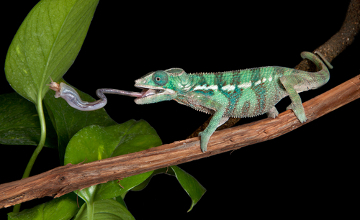You chameleons they are reptiles from the family Chamaeleonidae and include about 195 species. Some are so small that they measure just one centimeter, while others can measure up to 60 cm. These animals are found in Africa, parts of Europe, Arabia, India and Sri Lanka. According to the IUCN (International Union for the Conservation of Nature and Natural Resources), many species are critically endangered.
chameleons are beings daytime who live on top of trees, going to the ground only to change trees, mate, and lay their eggs. They feed mainly on flying insects and, to capture them, they stand waiting for the prey to appear, what many call the sit-and-wait technique.
When the insect passes close to it, the chameleon launches its big protractile tongue which can reach a distance of almost one meter. The tip of this organ is covered with an extremely sticky saliva, which helps in capturing its prey.
In addition to their great language, these beings have another notable characteristic: their eyes move independently. While one looks at one place, the other looks at another area. They are able to rotate their eyes up to an impressive 180 degrees.
are animals that live alone, joining another only in the breeding season. lay eggs, the incubation period can last up to a year. A kind of chameleon (Furcifer labordi) presents an interesting characteristic regarding its permanence inside the egg, it takes nine months to hatch and, after it is born, it only lives for another five months.

The chameleon launches its tongue very nimbly to capture its food
are relatively slow and therefore they are easily preyed upon. Its main predators are snakes, birds and other lizard species. However, these animals have a great strategy to avoid the attack of other animals. They have an impressive ability to change your color according to the environment in which they find themselves, their emotional state, age, gender and even time of year. With this impressive ability, moving slowly becomes an advantage as it goes unnoticed.
It is worth noting that they do not change color just to camouflage, this change also represents a way of Communication and even a way to control the temperature of the body. Some research suggests that chameleons use color change to fend off rivals as well as attract mates for breeding. Therefore, the color change is often more related to making the animal visible, and not just camouflaging it.
They can change color thanks to layers of cells with colored pigments called chromatophores. These cells can be of varying shades including green, red, pink, brown, blue, yellow, and black. Chromatophores are found just below the epidermis, which in these animals is transparent. The color change occurs thanks to hormones that are released by a region of the reptile's brain.
by Vanessa dos Santos
Graduated in Biology

